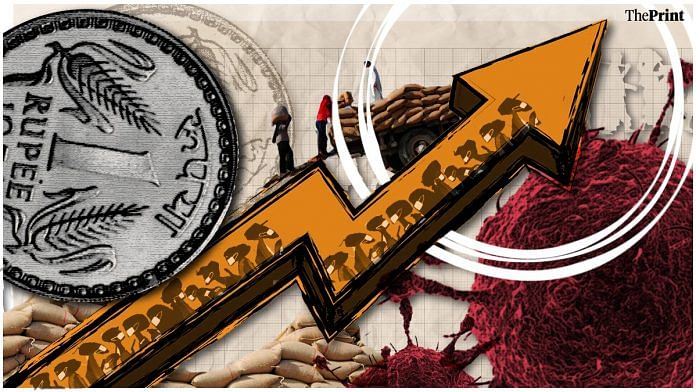Governments across the world have responded to the pandemic by increasing fiscal spending. At the same time central banks have increased liquidity. In the US, there are fears that expansionary fiscal and monetary policies could lead to overheating. This could translate into a sharp increase in US inflation as people step up spending with the economy getting back on track with the help of vaccines.
In India, consumer price index (CPI) inflation stood at 5.52 per cent in March compared to 5.03 per cent in February and 4.06 per cent in January. The rise in CPI inflation was driven by an increase in fuel and transportation costs along with an increase in some components of the food basket.
Moreover, the record Covid-19 surge across the country now, especially at a time when advanced economies have already started recovering, could put serious upward pressure on inflation.
Higher global inflation, rising commodity prices, local lockdowns and a weaker rupee could bring in higher prices in India.
Also read: Modi govt allowing foreign vaccines a welcome step, there are many economic & health benefits
Supply disruptions
While some in the US are worried about inflation rising mainly due to demand side effects, in India supply side factors are also expected to make a dent.
As Covid cases surge and deaths rise, collapsing health systems could push state and city governments to impose curfews and restrictions on movement. Local lockdowns and supply disruptions are likely to stay for a while.
Even though the government and businesses are better prepared than they were last year, the preparation is unlikely to suffice for the kind of surge being seen now. It appears that no one expected a second wave of this magnitude.
These supply disruptions could in themselves cause higher prices.
Global inflation
Over and above this, a rise in US inflation could affect India adversely in the coming months. Higher global inflation feeds into domestic prices through imported goods.
With the US economy recovering, commodity prices, including oil, have also risen and could rise further. This would mean higher imported inflation.
The wholesale price index (WPI) based inflation in India rose to an 8-year high of 7.39 per cent in March driven by increase in prices of fuel and manufactured products. Manufactured products have a weight of almost 65 per cent in the WPI. The surge in WPI inflation was driven by a steep increase in prices of metals, rubber, chemicals and textiles.
The global prices of these commodities have witnessed a sharp increase on the back of demand revival in advanced economies driven by the rollout of Covid vaccines. It is likely that the WPI based inflation could touch double digits in the near future due to a rise in prices of imported manufactured products and low base of last year.
In the CPI, food inflation touched almost 25 per cent in edible oils, and 13.25 per cent in pulses. The rise in global prices of edible oils could pose an upside risk to inflation. The seasonal pick up in prices of vegetables in the summer months along with local lockdowns could also push up inflation.
Also read: Manage govt interest burden or prevent price rise? RBI faces tough balancing act
Rupee depreciation
The US inflation rate of 2.6 per cent in March raised expectations about a Federal Reserve rate hike. Even though the US Fed decided not to raise interest rates in its latest Federal Open Market Committee meeting, markets expected that it would have to do so later this year.
Rising yields in the US would narrow the interest differential between the US and India, and could trigger a decline in the rupee.
Further, the rupee has been depreciating because of the Reserve Bank of India (RBI)’s measures to keep the interest rate on government bonds low. The RBI as the debt manager to the government has the responsibility of managing the government’s borrowing programme. The announcement of the G-Sec Acquisition Programme (G-SAP) led the rupee to fall by more than 1.5 per cent.
The outflows by foreign portfolio investors have placed an additional pressure on the rupee. Between the months of October and February, FPIs pumped in Rs 1.94 lakh crore as the economic recovery was gaining momentum.
However in the month of April, FPIs have been pulling out of the equity market as the resurgence of the second Covid wave and consequent lockdowns risk derailing a nascent economic recovery. A decline in the external value of rupee will make India’s imports, particularly crude oil, metals and edible oils more expensive.
Depreciation of rupee increases the rupee cost of imported commodities and this may transmit into a broad-based rise in price levels in the country.
Ila Patnaik is an economist and a professor at National Institute of Public Finance and Policy.
Radhika Pandey is a consultant at NIPFP.
Views are personal.
Also read: Why Modi govt has done well to maintain continuity in inflation targeting framework



